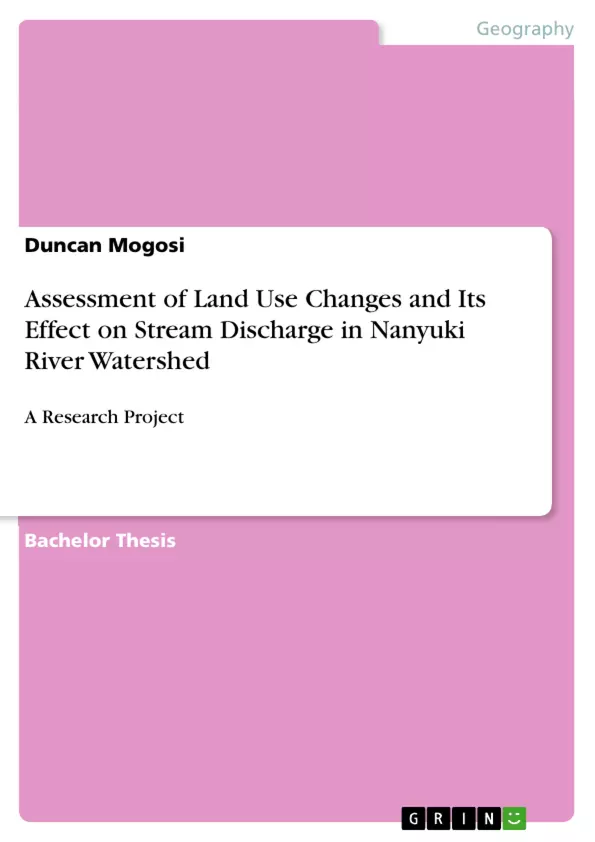Kenya is endowed with an array of internal wetlands dispersed around the main water basins, as it is in many developing countries in the world, its rural population is characterized by rapid growth rate over the past years. As such, watersheds are continually facing environmental degradation due to the limited supply of the resource and over exploitation to cater for this increasing population. This has resulted to immense land use conversion in the watershed that has a ripple effect on several elements of the watershed. Per se, the research aimed at assessing the land use change and its influence on stream discharge in Nanyuki River Watershed.
The main objective of the study is to assess the land use changes and its effect on stream discharge in Nanyuki River watershed. This is done by identifying and mapping the land uses; assessing the trend and periodicity in stream discharge and precipitation; and the correlation between forest cover and stream discharge between 1985 and 2008.
Based on the satellite imagery the land use change was assessed, where the forest cover areas were calculated and correlated to stream discharge data. This correlation established the direction and significance of association. The results showed an increased land use change where the forest cover in the watershed is reducing and impervious surfaces were also increasing between 1985 and 2015. The precipitation and stream discharge decreased between 1985 and 2015.The correlation between land use changes and the stream discharge showed a negative association. This means that as the land use changes increases the stream discharge decreases. The study concluded with recommendations that may be employed so as to realize an effective integrated watershed management plan that provides guidance on coordinated management, conservation and development within Nanyuki River watershed.
Inhaltsverzeichnis (Table of Contents)
- CHAPTER ONE: BACKGROUND OF THE STUDY
- 1.1 STATEMENT OF THE PROBLEM
- 1.2 RESEARCH QUESTIONS
- 1.3 RESEARCH OBJECTIVE
- 1.4 RESEARCH HYPOTHESIS
- 1.5 JUSTIFICATION
- 1.6 SIGNIFICANCE OF THE STUDY
- 1.7 SCOPE OF THE STUDY
- 1.8 LIMITATION OF THE STUDY
- 1.9 DEFINITION OF OPERATIONAL TERMS
- 1.10 CHAPTER OUTLINES
- CHAPTER TWO: LITERATURE REVIEW
- 2.0 INTRODUCTION
- 2.1 LAND USE/COVER CHANGES
- 2.2 LAND USE CLASSIFICATION
- 2.3 RAINFALL AND STREAM FLOW TREND DETECTION AND ANALYSIS
- 2.4 WAVELET ANALYSIS IN HYDROCLIMATIC STUDIES
- 2.5 THEORETICAL FRAMEWORK
- 2.6 CONCEPTUAL FRAMEWORK
- CHAPTER THREE: STUDY AREA
- 3.1 PHYSICAL SETUP
- 3.1.1 POSITION AND SIZE
- 3.1.2 CATCHMENT DESCRIPTION
- 3.1.3 PHYSIOGRAPHY
- 3.1.4 CLIMATIC CONDITION
Zielsetzung und Themenschwerpunkte (Objectives and Key Themes)
This research project aimed to assess the land use change in the Nanyuki River Watershed and its impact on stream discharge. The main objective was to identify and map land uses, analyze trends in stream discharge and precipitation, and determine the correlation between forest cover and stream discharge between 1985 and 2008.
- Land use change and its influence on stream discharge
- Trends in precipitation and stream discharge
- Correlation between forest cover and stream discharge
- Integrated watershed management plan
Zusammenfassung der Kapitel (Chapter Summaries)
- Chapter 1: This chapter introduces the research project, outlining the problem statement, research questions, objectives, hypothesis, justification, significance, scope, limitations, and definitions of operational terms. It also provides an overview of the project's structure.
- Chapter 2: This chapter delves into the existing literature on land use/cover changes, land use classification, rainfall and stream flow trend detection and analysis, wavelet analysis in hydroclimatic studies, the theoretical framework, and the conceptual framework.
- Chapter 3: This chapter focuses on the study area, providing information on its physical setup, including its position, size, catchment description, physiography, and climatic conditions.
Schlüsselwörter (Keywords)
The research focuses on land use change, stream discharge, Nanyuki River Watershed, forest cover, precipitation, integrated watershed management, and the correlation between land use changes and stream discharge.
- Quote paper
- Duncan Mogosi (Author), 2015, Assessment of Land Use Changes and Its Effect on Stream Discharge in Nanyuki River Watershed, Munich, GRIN Verlag, https://www.grin.com/document/378665



